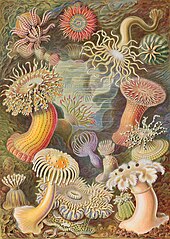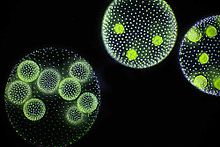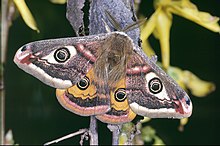A selection of animals showing a range of possible body symmetries, including both asymmetry, radial and bilateral body plans
Symmetry in biology is the balanced distribution of duplicate body parts or shapes within the body of an organism. In nature and biology, symmetry is always approximate. For example, plant leaves – while considered symmetrical – rarely match up exactly when folded in half. Symmetry creates a class of patterns in nature, where the near-repetition of the pattern element is by reflection or rotation.
The body plans of most multicellular organisms exhibit some form of symmetry, whether radial, bilateral, or spherical. A small minority, notably among the sponges, exhibit no symmetry (i.e., are asymmetric). Symmetry was once important in animal taxonomy; the Radiata, animals with radial symmetry, formed one of the four branches of Georges Cuvier's classification of the animal kingdom.
Radial symmetry

These sea anemones have been painted to emphasize their radial symmetry. (Plate from Ernst Haeckel's Kunstformen der Natur).
Radially symmetric organisms resemble a pie where several cutting planes produce roughly identical pieces. Such an organism exhibits no left or right sides. They have a top and a bottom surface, or a front and a back.
Symmetry has been important historically in the taxonomy of animals; Georges Cuvier classified animals with radial symmetry in the taxon Radiata (Zoophytes),[1][2] which is now generally accepted to be a polyphyletic assemblage of different phyla of the Animal kingdom.[3] Most radially symmetric animals are symmetrical about an axis extending from the center of the oral surface, which contains the mouth, to the center of the opposite, aboral, end. Radial symmetry is especially suitable for sessile animals such as the sea anemone, floating animals such as jellyfish, and slow moving organisms such as starfish. Animals in the phyla Cnidaria and Echinodermata are radially symmetric,[4] although many sea anemones and some corals have bilateral symmetry defined by a single structure, the siphonoglyph.[5]
Lilium bulbiferum displays typical floral symmetry with repeated parts arranged around the axis of the flower.
Many flowers are radially symmetric or actinomorphic. Roughly identical flower parts – petals, sepals, and stamens – occur at regular intervals around the axis of the flower, which is often the female part, with the carpel, style and stigma.[6]
Gastroenteritis viruses have radial symmetry, being icosahedral: A rotavirus, B adenovirus, C norovirus, D astrovirus.
Many viruses have radial symmetries, their coats being composed of a relatively small number of protein molecules arranged in a regular pattern to form polyhedrons, spheres, or ovoids. Most are icosahedrons.[7]
Special forms of radial symmetry
Tetramerism is a variant of radial symmetry found in jellyfish, which have four canals in an otherwise radial body plan.
Apple cut horizontally, showing pentamerism
Pentamerism (also called pentaradial and pentagonal symmetry) means the organism is in five parts around a central axis, 72° apart. Among animals, only the echinoderms such as sea stars, sea urchins, and sea lilies are pentamerous as adults, with five arms arranged around the mouth. Being bilaterian animals, however, they initially develop with mirror symmetry as larvae, then gain pentaradial symmetry later.[8]
Flowering plants show fivefold symmetry in many flowers and in various fruits. This is well seen in the arrangement of the five carpels (the botanical fruits containing the seeds) in an apple cut transversely.
Hexamerism is found in the corals and sea anemones (class Anthozoa) which are divided into two groups based on their symmetry. The most common corals in the subclass Hexacorallia have a hexameric body plan; their polyps have sixfold internal symmetry and the number of their tentacles is a multiple of six.
Octamerism is found in corals of the subclass Octocorallia. These have polyps with eight tentacles and octameric radial symmetry. The octopus, however, has bilateral symmetry, despite its eight arms.
Spherical symmetry
Spherical symmetry occurs in an organism if it is able to be cut into two identical halves through any cut that runs through the organism's center. Organisms which show approximate spherical symmetry include the freshwater green alga Volvox.[4]
Bilateral symmetry
In bilateral symmetry (also called plane symmetry), only one plane, called the sagittal plane, divides an organism into roughly mirror image halves. Thus there is approximate reflection symmetry. Internal organs are however not necessarily symmetric.
The small emperor moth, Saturnia pavonia, displays a deimatic pattern with bilateral symmetry.
Animals that are bilaterally symmetric have mirror symmetry in the sagittal plane, which divides the body vertically into left and right halves, with one of each sense organ and limb group on either side. At least 99% of animals are bilaterally symmetric, including humans,[9][10][11] where facial symmetry influences people's judgements of attractiveness.[12]
When an organism normally moves in one direction, it inevitably has a front or head end. This end encounters the environment before the rest of the body as the organism moves along, so sensory organs such as eyes tend to be clustered there, and similarly it is the likely site for a mouth as food is encountered.[11] A distinct head, with sense organs connected to a central nervous system, therefore (on this view) tends to develop (cephalization). Given a direction of travel which creates a front/back difference, and gravity which creates a dorsal/ventral difference, left and right are unavoidably distinguished, so a bilaterally symmetric body plan is widespread and found in most animal phyla.[11][13] Bilateral symmetry also permits streamlining to reduce drag, and on a traditional view in zoology facilitates locomotion.[11] However, in the Cnidaria, different symmetries exist, and bilateral symmetry is not necessarily aligned with the direction of locomotion, so another mechanism such as internal transport may be needed to explain the origin of bilateral symmetry in animals.[11][14]
The phylum Echinodermata, which includes starfish, sea urchins and sand dollars, is unique among animals in having bilateral symmetry at the larval stage, but pentamerism (fivefold symmetry) as adults.[15]
Bilateral symmetry is not easily broken. In experiments using the fruit fly, Drosophila, in contrast to other traits (where laboratory selection experiments always yield a change), right- or left-sidedness in eye size, or eye facet number, wing-folding behavior (left over right) show a lack of response.[16]
Females of some species select for symmetry, presumed by biologists to be a mark (technically a "cue") of fitness. Female barn swallows, a species where adults have long tail streamers, prefer to mate with males that have the most symmetrical tails.[17]
Flower of bee orchid (Ophrys apifera) is bilaterally symmetrical (zygomorphic).
The lip of the flower resembles the (bilaterally symmetric) abdomen of a
female bee; pollination occurs when a male bee attempts to mate with
it.
Flowers in some families of flowering plants, such as the orchid and pea families, and also most of the figwort family,[18] are bilaterally symmetric (zygomorphic).[19]
Biradial symmetry
Biradial symmetry is a combination of radial and bilateral symmetry, as in the ctenophores. Here, the body components are arranged with similar parts on either side of a central axis, and each of the four sides of the body is identical to the opposite side but different from the adjacent side. This may represent a stage in the evolution of bilateral symmetry "from a presumably radially symmetrical ancestor."[14]Asymmetry
Not all animals are symmetric. Many members of the phylum Porifera (sponges) have no symmetry, though some are radially symmetric.[20]It is normal for essentially symmetric animals to show some measure of asymmetry. Usually in humans the left brain is structured differently to the right; the heart is positioned towards the left; and the right hand functions better than the left hand.[21] The scale-eating cichlid Perissodus microlepis develops left or right asymmetries in their mouths and jaws that allow them to be more effective when removing scales from the left or right flank of their prey.[22]
The approximately 400 species of flatfish also lack symmetry as adults, though the larvae are bilaterally symmetrical. Adult flatfish rest on one side, and the eye that was on that side has migrated round to the other (top) side of the body.[23]








